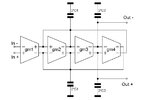ICdesignerbeginner
Member level 5
Hi
I have two different biquad circuits. Fisrt biquad shown in the attached figure is a fully differential biaquad with four gm blocks while the second figure shows a single ended biquad with two gm blocks. I want to know why in the first circuit four gm blocks are used while in second circuit two gm blocks are used. A biquad can be designed using two gm blocks and two capacitors what is the reason of using four gm blocks in first ciruit? The difference is not the fully differential or single ended version.

I have two different biquad circuits. Fisrt biquad shown in the attached figure is a fully differential biaquad with four gm blocks while the second figure shows a single ended biquad with two gm blocks. I want to know why in the first circuit four gm blocks are used while in second circuit two gm blocks are used. A biquad can be designed using two gm blocks and two capacitors what is the reason of using four gm blocks in first ciruit? The difference is not the fully differential or single ended version.


